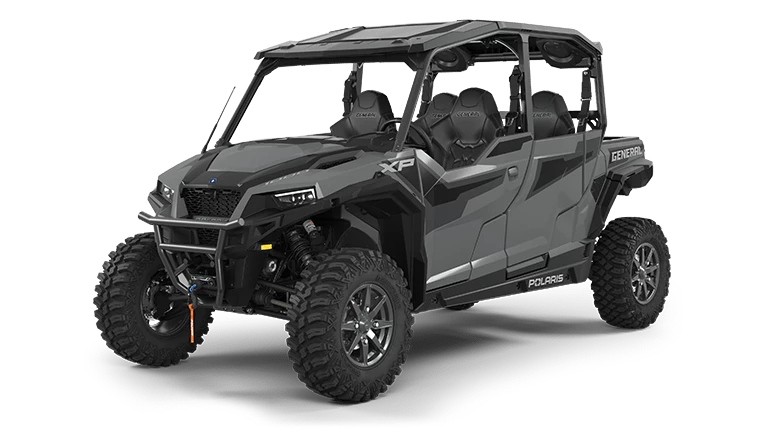As an Amazon Associate I may earn a commission from qualifying purchases at no additional cost to you.
When comparing the maintenance requirements between a 2-stroke ATV and a 4-stroke Side by Side, the distinctions become quite apparent.
A 2-stroke ATV is generally more straightforward due to its simpler engine design, which typically requires less frequent and less costly maintenance. The nature of 2-stroke engines allows for quicker repair and component replacement, making them appealing to those who prefer minimal upkeep.

In contrast, 4-stroke Side by Sides demand a more comprehensive maintenance routine. These vehicles often have longer service intervals, but the complexity of the 4-stroke engine means regular checks and specific services, such as oil changes and valve adjustments, are essential. This might present a higher cost and more involved effort, requiring a closer adherence to service schedules.
Understanding ATV and Side by Side Fundamentals
2-stroke ATVs and 4-stroke Side by Sides differ significantly in engine construction and functionality. These distinctions impact maintenance, performance, and fuel efficiency.
2-Stroke ATV Characteristics
2-stroke engines are known for simplicity, often featuring fewer moving parts compared to 4-strokes.
Fuel and oil are mixed together, reducing the need for separate engine oil systems. This design generally means less maintenance, with no valve adjustments required.
Fuel injection in some modern models enhances efficiency and performance. The ignition system in 2-stroke engines is usually less complicated, improving reliability. Despite their advantages in simplicity, they often require more frequent attention to the fuel system to prevent clogs or buildup due to oil additives.
4-Stroke Side by Side Features
4-stroke Side by Sides are typically equipped with more complex systems but provide power and efficiency.
The engine oil is separate, allowing for cleaner operation and longer service intervals. This separation, however, means more components to maintain, like the valve mechanism.
Advanced fuel injection systems in 4-stroke engines grant precise control over fuel delivery, enhancing power delivery and fuel economy. Ignition systems tend to be intricate but offer increased performance and reliability. While the maintenance can be more involved, the performance and durability benefits make it appealing to many enthusiasts.
Maintenance Fundamentals
Understanding the maintenance needs of a 2-stroke ATV and a 4-stroke Side by Side is crucial. Each requires different service intervals and maintenance tasks to ensure optimal performance and longevity.
Routine Maintenance Overview
Routine maintenance for a 2-stroke ATV generally requires more frequent attention due to its engine design, which typically leads to more rapid wear.
Oil changes are a regular task since the oil mixes with the fuel and needs frequent replenishing. Air filters should be inspected often due to potential clogging from outdoor use.
For 4-stroke Side by Sides, routine maintenance intervals are typically longer, given their more complex engineering and separate lubrication system.
Fuel lines should be checked periodically to avoid damage or blockages, while the electrical system requires regular monitoring for any signs of wear or malfunction.
Comparing Service Intervals
The service intervals for 2-stroke ATVs are usually shorter compared to those for 4-stroke Side by Sides.
2-strokes demand more frequent oil and spark plug replacements due to their more straightforward, less efficient combustion process. A typical 2-stroke might need servicing every 10-20 hours of use.
In contrast, 4-stroke Side by Sides generally feature longer intervals between services. Their complex engine architecture allows for extended periods before requiring an oil change, often every 50-100 hours. This makes them more suited for users prioritizing longer intervals between services.
Essential Maintenance Tasks
For a 2-stroke ATV, essential tasks include regular oil checks, air filter cleaning, and spark plug replacements.
These vehicles also benefit from periodic inspections of the engine and exhaust systems due to high residue levels. Regular maintenance ensures the engine runs smoothly and prevents excessive wear.
In a 4-stroke Side by Side, routine tasks involve more detailed engine inspections, oil and filter changes, and electrical system checks.
Checking the valve adjustments and replacing worn belts are also important steps. These maintenance tasks help sustain performance and extend the vehicle’s lifespan.
Simplifying ATV Care
When considering the maintenance of ATVs, 2-stroke models stand out for their straightforward upkeep. They require fewer components and simpler tasks compared to their counterparts, making them particularly appealing to those who prefer minimal maintenance efforts.
Ease of Maintenance for 2-Stroke ATVs
2-stroke ATVs are known for their mechanical simplicity. They have fewer moving parts than 4-stroke engines, reducing the complexity of routine checks.
Typical tasks include checking the spark plug and assessing fuel mixture.
In environments with varied terrain, their lightweight design makes them easier to handle and maintain without heavy equipment. Oil changes are eliminated as the oil is mixed with the fuel, further reducing servicing time. This design reduces wear on components, leading to fewer breakdowns and lower overall maintenance costs.
Basic Maintenance Requirements
To keep a 2-stroke ATV in optimal condition, focusing on basic maintenance tasks is key.
Regularly cleaning the air filter and ensuring a proper fuel-to-oil ratio are vital. The absence of an oil filter simplifies service as well.
Engine cooling involves ensuring that radiators or air-cooling systems are clear of debris. Because lubrication is mixed with fuel, monitoring oil levels is important to avoid engine damage. These tasks provide efficient upkeep without the need for specialized skills or expensive parts.
Servicing Side by Sides
Side by sides require regular maintenance to prolong their lifespan and ensure peak performance. The complexities of the 4-stroke engines and the necessary service checkpoints are crucial aspects of this maintenance routine.
4-Stroke Engine Complexities
4-stroke engines in side by sides are celebrated for their efficiency and power. These engines incorporate numerous components, including camshafts, valves, and timing chains, all of which demand precise maintenance.
Unlike the simpler 2-stroke engines, 4-stroke engines require regular oil changes and valve adjustments due to the intricate mechanisms involved.
In climates with extreme temperatures, these components may require more frequent checks. Filtering systems also need consistent attention to prevent contaminants from causing damage. Awareness of the specific manufacturer guidelines is essential as each model and make can have different needs. With proper care, these engines can handle various terrains and loads effectively.
Regular Service Checkpoints
Regular service intervals for side by sides ensure the vehicle remains in optimal working condition. Essential checkpoints involve inspecting brakes, changing fluids, and tightening bolts.
Each ride can affect the performance differently, especially in regions with rough terrain. Regular service includes oil changes, brake checks, and inspecting the suspension system.
Routine maintenance should also account for the vehicle’s mileage and weight.
For vehicles in more populated areas with frequent usage, such checkpoints might be necessary more often than manufacturer recommendations. Adhering to a comprehensive service schedule can prevent more significant repairs and ensure the side by side remains reliable under various conditions and usage frequencies.
Maintenance in Different Environments
Operating an ATV or a Side by Side in varying environments necessitates adjustments in maintenance routines. Factors like terrain and climate heavily influence how often and what type of servicing is required to keep these vehicles performing optimally.
Adjusting Maintenance to Terrain
Different terrains impose unique demands on ATVs and Side by Sides.
Rough mountain terrains require frequent checks for suspension integrity due to the uneven surfaces. Traversing rivers and other water bodies may necessitate additional maintenance of the exhaust and intake systems to avoid damage from water exposure.
In regions with lots of dust, like cascades, air filters need regular cleaning to prevent debris buildup.
Conversely, riding in wet, muddy conditions could lead to quicker wear of brake systems, mandating more frequent inspections and replacements to maintain safety and effectiveness.
Climate Considerations
Climate plays a crucial role in establishing maintenance schedules.
In Virginia’s humid climate, moisture can lead to increased rust and corrosion, so regular frame and component inspections are vital. High humidity areas also demand lubricating the moving parts more frequently to prevent seizing.
Cold environments require different considerations. Engine oils and lubricants should be checked and possibly altered seasonally to ensure they retain the right viscosity in low temperatures. Proactive measures can help maintain peak performance and extend the lifespan of the vehicle.
Practical Maintenance Tips

Two-stroke ATVs and four-stroke Side by Sides have distinct maintenance needs. Understanding efficient practices and cost-effective strategies maximizes performance while minimizing expenses.
Efficient Maintenance Practices
For two-stroke ATVs, simplicity defines their design, resulting in straightforward maintenance.
Regularly checking and maintaining the air filter is crucial. A dirty air filter can affect performance and lead to engine issues. Cleaning or replacing it ensures optimal airflow.
Two-stroke engines require oil mixed with gasoline. Checking and using the correct oil-fuel ratio is vital. Proper ratio ensures lubrication, preventing wear and tear on engine parts.
For four-stroke Side by Sides, consistent oil changes are necessary due to their separate oiling system.
Keeping the oil clean ensures engine longevity. Regularly checking the coolant level prevents overheating. These preventive measures help maintain performance and avoid costly repairs.
Cost-Effective Maintenance
Maintaining ATVs and Side by Sides economically is crucial, especially for commercial use or if they are part of a fleet.
Bulk purchasing essential parts like spark plugs, air filters, and oil can significantly reduce costs. Partnering with vendors or looking for commercial discounts can lead to savings.
Regular inspections help identify potential issues before they escalate into costly repairs.
Involving non-specialist staff in basic maintenance, like checking tire pressure or inspecting brake pads, can save money. This approach streamlines costs and extends the life of these vehicles.
Properly maintained vehicles reduce downtime and increase productivity, making them valuable assets in any commercial operation.
Regulatory and Cultural Considerations

Understanding the maintenance of ATVs and Side by Sides involves navigating legal parameters and cultural values that influence practices. This section examines the impact of regulations on service routines and how cultural factors shape maintenance approaches.
Maintenance and the Law
Regulations governing ATVs and Side by Sides vary significantly across regions. Local and national laws dictate safety standards, emissions guidelines, and noise levels.
It is crucial for operators to comply with these regulations to avoid penalties.
In the United States, laws concerning vehicle maintenance often reflect broader environmental and safety concerns embedded in the Constitution and regional histories.
For example, some towns require regular emissions testing, especially for older two-stroke engines, to adhere to environmental protections.
ATV operators should also consider regulations related to where and how vehicles can be serviced. Many laws emphasize maintaining vehicles in designated areas or buildings to prevent environmental damage.
Cultural Influences on ATV Care
Cultural factors play a significant role in how ATVs and Side by Sides are maintained. In some regions, communities embrace a rich tradition of hands-on maintenance passed down through generations. This reflects a cultural value of self-reliance and mechanical ingenuity.
Religion and historical perspectives can also influence attitudes toward maintenance. For instance, regions with deep ties to conservation may prioritize sustainable practices and long-lasting maintenance solutions.
In other areas, faster-paced lifestyles influenced by urban settings lead to reliance on professional services. This choice reflects an appreciation for expert care and efficiency over the traditional DIY approach.
Future of ATV and Side by Side Maintenance

The future of ATV and Side by Side maintenance is shaped by innovation and technology.
Emphasis on smart diagnostics and connectivity tools is growing, allowing real-time monitoring and predictive maintenance.
Users benefit from apps providing engine metrics and maintenance reminders, reducing unexpected breakdowns.
Commercial production teams explore automated manufacturing processes. These innovations enhance parts precision, increasing reliability.
Enhanced energy efficiency is a focus, driven by advancements in engine technology.
Cummins, known for durable power systems, is investing in eco-friendly engines for off-road vehicles.
Electric and hybrid ATVs and Side by Sides are becoming more common, offering reduced maintenance through fewer mechanical parts and lubricants.
Rough terrains impact maintenance needs. As engine designs advance, vehicles can better handle rugged roads while maintaining peak performance.
Understanding these innovations helps users adapt to evolving maintenance demands.
Utilizing lists in design advancements, such as:
- Smart Diagnostic Tools
- Efficient Engine Technology
- Enhanced Manufacturing Processes
leads to better maintenance practices. Vehicle longevity and user satisfaction improve with integration of new technology.








